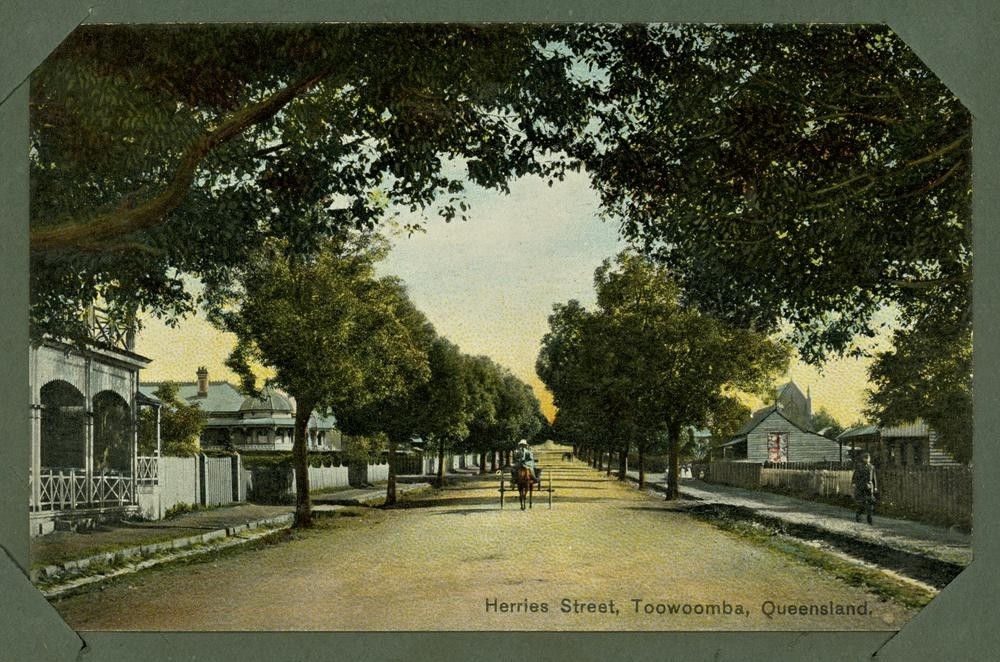The story of the Toowoomba Carnival of Flowers
By Annabelle Tonkin, Collection Curation and Engagement | 5 September 2025

For the month of September, the grass really is greener in Toowoomba. Tourists arrive in spades for the Toowoomba Carnival of Flowers, Australia’s longest running flower festival.
Queensland’s largest inland city springs to life: gardens in bloom, floral floats, and the region’s finest produce are all on show. While parades down camphor laurel lined streets have been taking place since 1949, Toowoomba has been known as ‘the garden city’ since the 1890s.

Its rich history extends far beyond the horticultural developments of colonialisation, which saw a settlement established on the country of the Jagera, Giabal, and Jarowair people. The area has remained a key meeting place for millennia, as a place where the country of three traditional owners converges.
Why is Toowoomba called the Garden City?
Just over 120km west of Brisbane, the city of Toowoomba sits atop the Great Dividing Range: a picturesque urban landscape blending country charm with modern sensibilities.
The fitting moniker of 'The Garden City' is due to Toowoomba's almost ideal gardening conditions: a mild climate, regular rainfall, and plenty of rich, volcanic soil. As a result, the city is home to around 200 public parks and gardens, with even more thriving residential gardens.

In the early years of colonial settlement, Toowoomba was described as ‘the swamps’ and known for unsanitary conditions. Through the town's burgeoning development, it became known as the ‘gateway to the Darling Downs’.



The history of the Toowoomba Carnival of Flowers
The idea of the Carnival of Flowers first took root in 1949, thanks to the vision of local businessman Essex Tait and the Toowoomba Chamber of Commerce, to revive the city post-war. The proposal leveraged Toowoomba’s reputation as ‘The Garden City’ to attract visitors, reinvigorate the economy, and celebrate community.

Once this seed was planted, it wasn’t long before it grew to fruition, with the first festival taking place on 21 October 1950. A bullock team led the first Grand Parade through the heart of the city, trailed by floral floats and marching bands, enjoyed by over 50,000 spectators lining the streets.


The inaugural Carnival Queen, Fay Ryan, raised over £765 to support the development of community infrastructure, such as youth centres and a Mothercraft hub. The Chronicle Garden Competition attracted green thumbs from far and wide.
By all reports, the success of the event suggested a budding tradition was starting to bloom. The following year, the Carnival moved to September to better align with the beginning of Spring and the city’s school holidays.


New growth: a modern Toowoomba Carnival of Flowers
Carnival festivities have evolved into a month-long celebration, usually from mid-September to early October. Over four weekends, there are hundreds of activities and events available to festival goers, including a festival of food and wine, parkland entertainment, tours of magnificent gardens, live music, twilight tours, wine tastings, art shows, and of course, the parade.

In 2020, the Carnival marked its 70th year – a milestone that was commemorated with a special “reimagined” format due to the COVID-19 pandemic. Despite restrictions, the community rallied to keep the spirit alive with garden trails, virtual tours, and a renewed focus on local flora and regional pride. It served as a testament to the event's resilience and enduring appeal.
The Carnival continues to be not only a beloved tradition, but a major economic driver for the region. In 2021, the event contributed 22 million dollars to the local economy, with over 300,000 visitors from across the world travelling to attend.

A quieter Carnival of Flowers in 2020
In 2024, the Carnival’s global reach saw a temporary installation of the region's native plants and produce in Singapore, at the Flower Dome Gardens. This collaboration came as a celebration of the Carnival’s 75th anniversary and as an opportunity to promote tourism and trade with the Toowoomba Region.

While the Carnival has evolved over the years, its core remains unchanged: a celebration of horticulture and community that defines a region. The 2025 Toowoomba Carnival of Flowers promises visitors a range of wonderful experiences as they wander through prize-winning floral displays, marvel at intricate parade floats, ride a Ferris Wheel in Queens Park botanic gardens, take a train ride to heritage listed Spring Bluff Railway Station and savour local produce.
Toowoomba Carnival of Flowers, 1958
Explore more about the Toowoomba Carnival of Flowers through State Library collections.
74th Annual Toowoomba Carnival of Flowers photographs
9955, Toowoomba Carnival of Flowers Photographs
7558, Jim and Mary Hardie Slides
Jubilee souvenir : Carnival of Flowers Toowoomba
The Carnival of Flowers : a case study in regional tourism / Deborah Tranter and Karen Douglas

Comments
Your email address will not be published.
We welcome relevant, respectful comments.